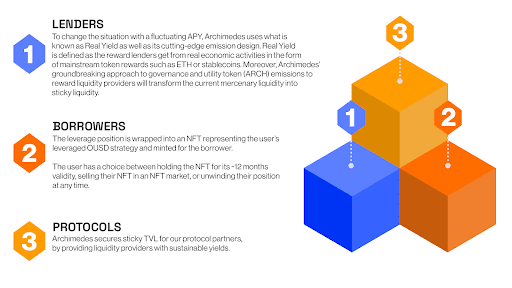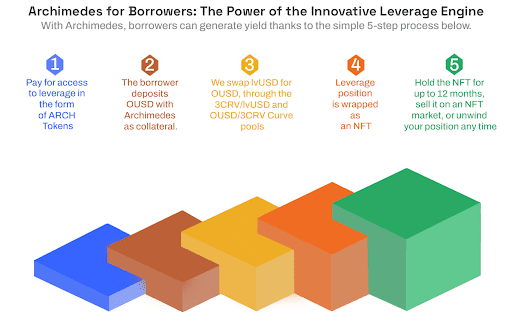Archimedes is a state-of-the-art lending and borrowing marketplace built on AMMs that attracts capital by offering a high native and sustainable real yield to lenders, allows borrowers to create leveraged positions of up to x10 on yield-bearing stablecoins via innovative mechanisms, and enables partner protocols to attract sustainable capital.
In both Traditional (TradFi) and Centralized Finance (CeFi), making your money work to generate income most likely places you behind inflation. In Decentralized Finance (DeFi), despite historical returns being better than the alternatives, it currently provides low average yields on stablecoins at a higher risk without breaking the inflation threshold: in Decentralized Exchanges (DEXs) and Automated Market Makers (AMMs), average returns are below 5%, all of this while inflation rates are currently consistently above 5%. Chances are, your capital is losing value over time.
Introducing Archimedes
Archimedes builds an inventive decentralized and overcollateralized lending and borrowing market on top of existing AMMs. Archimedes creates Curve pools to attract liquidity by offering access to stable, relatively low-risk and top of market returns from real yield and its innovative dynamic emissions of its novel governance and utility token, ARCH. By rewarding liquidity providers with sustainable and long lasting yields, Archimedes secures long lasting Total Value Locker (TVL) for protocol partners.
Lastly, borrowers (leverage takers) are able to borrow liquidity from these pools using leveraged positions of up to 10x on yield-bearing stablecoins. That means up to a mind blowing 50% APY in current market conditions, all of it with lower liquidation risk. Archimedes then wraps each leveraged position with an NFT, which the user can trade without the need to unwind the position.

Using this trifecta effect approach combined with great user experience, Archimedes is able to achieve its long-term vision: to unlock sustainable, long-term, and accessible opportunities to everyone.
“It is one of the simplest experiences I’ve had in DeFi”, Everton Matheus, DeFi user and YouTuber
Potential Archimedes users include NFT users who want an easy on-ramp into DeFi and are looking for a new financial use case, as well as CeFi users with little to no knowledge of DeFi who want more exposure to appreciating stabletokens.
Lenders and Protocols: the mercenary liquidity problem
It’s not just users that are limited in their gains, but also the vast majority of the protocols are scrambling to retain capital (liquidity). Most of the existing opportunities in DeFi are unsustainable and inefficient due to protocols rewarding lenders (aka liquidity providers) with poor token emission designs, which is typically a result of the combination of governance token emissions from the protocol and the DEX/AMM of choice.
Although these emission rewards can be initially compelling to investors, they can quickly attract relatively large amounts of liquidity, which then dilute the average APY of the pool. This causes investors to constantly pool hop in the quest for the next best pool APYs, causing protocols to quickly attract and lose liquidity, also known as the mercenary liquidity problem. Additionally, this type of pool hopping yield farming strategy requires high maintenance from large investors and can cost prohibitive gas fees for retail and smaller investors. This effect also creates sell pressure on tokens being used to reward lenders given the lack of utility, causing prices to quickly drop.
So, what other options are there? If you cannot go to AMMs, you might go to AAVE, Compound, or similar solutions, but you will quickly realize that returns are <5% for stablecoins. Maybe go to some centralized players? Well, we’ve all seen how it ended up with Celscius and 3 Arrows type of investments, and more recently FTX.
Borrowers: the incentives alignment problem
The liquidity provided in such pools are largely used for lending / borrowing activities. Investors can borrow funds to do a range of things – among them is Leverage.
Leverage, if done right, can generate great returns. Nevertheless, most existing solutions in DeFi use a model that jeopardizes a large portion of the user’s funds in order to increase the project’s revenue – there is a strong incentive misalignment through a win-lose relationship.
This is typically done via liquidation: to access leverage, borrowers typically deposit collateral to access loans; these borrowers are then liquidated when their loans become undercollateralized, which means their collateral value has dropped to the point that the user cannot pay their debt.
Additionally, understanding most DeFi existing solutions, including AMMs and Leverage protocols, is not an easy task, even for the most technical and financially savvy investors, due to these solutions lacking a simple and intuitive user experience.
This all begs the question: What if a protocol could make their options sustainable and accessible to all stakeholders in both lending and borrowing markets?
That is what Archimedes is designed to do. By addressing the issues of unsustainable pool rewards, mercenary liquidity, incentives alignment, and user experience, Archimedes is redesigning what DeFi is today and is reimagining what DeFi can look like in the future.
Archimedes for Lenders: Using the Power of Real Yield and Dynamic Emissions
Because APYs fluctuate between projects and pools frequently, investors are left to “pool hop” to redeploy their investments from pools with lower or falling APYs to whatever better alternatives are available. Thanks to the mercenary liquidity pool hopping quest for the highest APY, network fees have put retail investors increasingly on the sidelines, benefiting the whales, who are now dominant in the crypto investing space.
To help change this narrative, Archimedes uses what is known as Real Yield, as well as a cutting-edge token emission design.
Real Yield is defined as the reward lenders get from real economic activities in the form of mainstream tokens such as ETH or stablecoins. When implemented correctly, Real Yield can help avoid the expensive pool hopping, harvesting, and compounding fees investors might incur. Users can avoid all the hassle by enjoying the benefits of this type of approach, which is a drastic improvement and a huge benefit to current market offerings.
Moreover, Archimedes’ groundbreaking approach to governance and utility token (ARCH) emissions to reward liquidity providers can transform current mercenary liquidity providers into sticky or long-lasting liquidity. The Archimedes protocol’s emission rate is designed to be adaptable in order to avoid overinflation and provide competitive APY at different market scenarios and conditions. In its novel approach, Archimedes calculates the ARCH emission volume every two weeks based on the ARCH price and considering top pools and market APYs, so that its rewards are consistently attractive to Liquidity Providers, creating sustainability for the stakeholders involved.
By bringing both a Real Yield and innovative token emissions approach to lending and borrowing marketplaces, Archimedes will not only make APYs sustainable for liquidity providers, it will also create stability for the TVL of its own, and partners’ liquidity pools. This type of approach makes it possible to further unlock larger and more predictable leverage availability to Archimedes’ borrowers. This approach also allows both pools and the Archimedes’ Leverage Engine to scale.
Archimedes for Borrowers: The Power of the Innovative Leverage Engine
With Archimedes, borrowers can generate yield in just a few clicks, thanks to a simple 5-step process happening behind the scenes.
1) Every time Archimedes’ makes leverage available (rounds), the user pays upfront for access to leverage in the form of ARCH, Archimedes’ utility and governance token.
a) Archimedes applies its innovative bidding mechanism to set the price of every $ worth of leverage.
b) Users will bid based on what they think the OUSD yield will be worth in the future.
c) At each round, Leverage price start at a certain value and reduces over time, but the access to leverage is limited and could unavailable for the ones waiting for price to drop.
2) The borrower deposits OUSD as collateral to Archimedes.
3) Archimedes’ leverage engine then mints lvUSD, Archimedes’ stablecoin, and swaps it for OUSD corresponding to the amount of leverage desired.
a) This is done through the 3CRV/lvUSD and OUSD/3CRV Curve pools.
4) The leverage position is then wrapped into an NFT representing the user’s leveraged OUSD strategy and minted for the borrower.
a) Only the NFT holder will have the rights to unwind the leveraged position and its assets.
5) A user then chooses between holding the NFT for its ~12 months validity, selling their NFT in an NFT market, or unwinding their position at any time.
a) After 12 months a user can still choose to hold the NFT. However, it will no longer be earning a yield unless the leverage is renewed with a payment of ARCH tokens when leverage is available.

The engine receives OUSD as collateral and returns OUSD to the user once the position is closed, making the need for liquidation a thing of the past. This means you can borrow up to 10x and watch your position grow without the risks seen in alternative protocols.
Benefits
Lenders, borrowers, and protocols all benefit from Archimedes’ revolutionary new approach to DeFi. What this does is help Archimedes create a sustainable lending / borrowing market that pays interest natively for both user types.
Archimedes uses only yield-bearing and battle-tested stablecoins within its leverage engine, starting with OUSD – from Origin Protocol – with other appreciating assets coming soon after. The assets Archimedes partners with will always be filtered by its rigorous due diligence, allowing only high quality fully collateralized yield-bearing stablecoins.
Its innovative Dutch Auction (bid for acquiring leverage) and utility of ARCH also create incentives for ARCH token owners to hold it long term. Since positions are also tied to tradable NFTs, users can trade their positions without unwinding them. Also, because leverage allocation is limited, many investors may be willing to pay a premium for these NFTs. In this way, Archimedes’ incentives are aligned with its stakeholders’ best interests: it’s designed to be sustainable and to provide top of market yield.



































